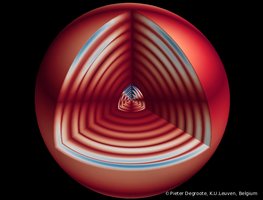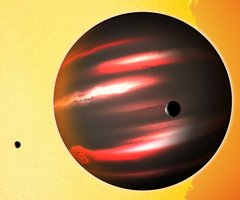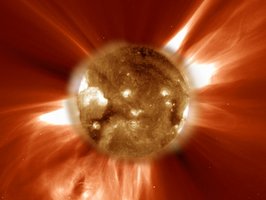
Asteroseismology and breakthroughs in our understanding of stars are driven by improved frequency accuracy. To achieve this, observations extending over weeks or months, as far as possible be continuous in time, are needed. This requires coordinated observations from several sites at mid-latitude on Earth, or observations from space. The present WP will coordinate and develop existing and future state-of-the-art asteroseismic projects which form the central and crucial part of the project. Observations of stellar oscillations can be carried out with two techniques: (1) observations from space through time-series imaging of variations in stellar luminosity; and (2) spectroscopic observation, through the Doppler effect, of the velocity of the stellar surface. The observed signals are very small, for the solar-like oscillations that are the main focus in the present project. The luminosity oscillations are a few parts per million and the velocities are typically less than 50 cm/sec. This places extreme constraints on the observational techniques. The main observational basis for the present proposal are three major observational projects: (1) Asteroseismic observations in luminosity from the NASA Kepler mission, (2) Doppler-velocity observations from the dedicated SONG network and (3) Solar oscillations from the BiSON and GONG networks and from the SoHO and SDO satellites. The main output from the present WP will be oscillation frequencies and other basic properties of the oscillations. The existing techniques for analysis of stellar and solar oscillations will be further developed and tested through application to realistically simulated data, e.g., provided by the asteroFLAG collaboration, as well as to the very extensive material of whole-disk solar oscillation observations which are directly comparable to stellar data. For huge data sources such as Kepler, CoRoT and PLATO we expect to use robust and accurate automated data fitting routines, and those techniques will enable the broad use of asteroseismology as a general tool for measuring stellar parameters. This WP will form the basis for WP4 and will provide crucial input for WP5 and WP6 as well as additional data for WP2 and WP3.

Data on dozens of transiting exoplanets exist and more are on the way. We will focus on exoplanet masses and radii, atmospheric photometry or spectra of transiting planets, and polarimetry of hot Jupiters. Kepler will measure radii and masses for hundreds of exoplanets. We will utilize this information to learn about the range of interior compositions possible amongst planetary systems, such as whether the planets have significant H or H/He envelopes, or whether the planets are almost entirely rocky as akin to larger versions of solar system planets. Dozens of hot Jupiter atmospheres have been identified. We will review the studies of hot Jupiters and determine the successes and failures of the modelling efforts in preparation for interpreting super-Earth atmospheres. The super Earth GJ 1214b has a growing number of data sets that are not fully understood in aggregate. We will focus on modelling GJ 1214b´s atmosphere and any other as yet to be discovered super Earths. A subset of exoplanets is amenable to polarization measurements. Polarimetric studies of exoplanets extend their detection outside transits and allow us to characterize the composition of their upper atmospheres. A combination of the constraints on the stellar radius from asteroseismology, planet radius from transit measurements, and planet reflectivity from secondary eclipses and polarimetry will result in unprecedented disentanglement of these parameters.

Magnetic fields are apparently rather ubiquitous among stars and play a key role in their activity and evolution. Basic techniques for detecting stellar activity are the same as for asteroseismology, i.e., photometry and spectroscopy, which reveal rotational modulation due to magnetic inhomogeneities. Kepler and CoRoT provide unprecedented sensitive and continuous photometric time series which significantly expand our ability to follow evolution of starspots and obtain realistic estimates of their lifetimes, rotation rates and intrinsic properties. Analysis of long helioseismic datasets has demonstrated the use of seismology as a powerful probe of solar activity, and its variations over time. The availability of long Kepler datasets on acoustic oscillations offers the prospects of ´sounding´ activity in a variety of solar-type stars of different masses and evolutionary states. The asteroseismic data may be used measure stellar cycle periods, and to place constraints on the latitudinal distribution of the near-surface magnetic activity and the depths of convective envelopes of the stars, key information for dynamo theorists. High-resolution spectroscopy of selected rapidly rotating stars with ground-based facilities (e.g. SONG) adds a second dimension to visualization of stellar surfaces (indirect imaging), while spectropolarimetry (e.g. SON) enhances it to the third dimension and reveals a 3D-structure of magnetized stellar atmospheres. Using these techniques simultaneously will help address questions such as: Do starspots have the same morphology as sunspots (umbra and penumbra)? What is the lifetime of individual spots? What is the faculae to spot ratio on different types of stars? How does this ratio and, hence, the stellar irradiance vary on the evolutionary time scale? Spectropolarimetric techniques will also be applied to and tested on the solar data. One of the key questions in solar physics is the structure and evolution of the huge component of quiet Sun magnetic fields. Do they originate from local or global dynamo processes? Do they vary with the solar cycle? If and how they are related with active regions? Answering these questions will further clarify the influence of the solar magnetism on Earth´s climate and ultimately planetary habitability.

The basis for the modelling effort is the observations, in the form of oscillation frequencies and amplitudes, resulting from WP1 and WP3, additional data on stellar properties, and existing codes for computing stellar evolution and oscillations. The goal of the WP is a greatly improved understanding of the physical properties of stellar interiors, leading to far more reliable procedures for stellar modelling and hence for the broader use of the models in other areas of astrophysics. This includes the determination of stellar properties in the analysis of exo-planets, under WP 2 and 6. The activities will include further improvements in stellar modelling, including comparisons of independent codes to check their reliability, detailed modelling of hydrodynamical phenomena to derive procedures for inclusion in general stellar modelling, and possibly including magnetohydrodynamical modelling of stellar activity, and improved computations of stellar oscillations, including effects of convection and non-adiabaticity. Techniques will be further developed for combining the observational data in forms that provide reliable tests of the models; for the data of very high quality expected from the SONG network this will include inversion techniques that allow direct inferences to be made about the properties of stellar cores. These techniques will be applied in a systematic and statistically well characterized way to the observational data. This will include the development of automated analysis procedures with a view towards the very large amount of data that will have to be analysed for the PLATO mission, if it is selected. Particular attention will be paid to red giants, where recent data have demonstrated an unexpected richness in the potential for asteroseismic investigations.
The SAC-node in Germany possesses advanced numerical codes for calculating synthetic spectra with model stellar atmospheres under various conditions, in particular radiative transfer codes for exploring polarization due to magnetic fields and scattering in atomic and molecular lines as well as micro-particles. These codes include the challenging computation of the molecular Paschen-Back effect, which is rather common in molecular lines at stellar magnetic fields. These theoretical and numerical tools establish the advanced framework for interpretation of polarized (as well as unpolarized) spectra. We will employ them for exploring Stellar Astrophysics Centre magnetic fields on the surfaces of various types of stars and the Sun. They also constitute cores of inversion codes for mapping temperature and magnetic fields on stellar surfaces and for obtaining thermodynamic properties with height in stellar atmospheres (3D structure of starspots).

The field of exoplanet atmospheres is well established with over three dozen exoplanet atmosphere measurements and computer codes and analysis for many different aspects of atmospheres. What is missing from the field is a comprehensive atmospheric retrieval technique for super-Earth and Earth-like planet atmospheres. While researchers have focused on the forward modelling problem, no one has carefully and exhaustively investigated the question of what we can really learn from super Earths and Earth-like planet atmospheres. We will develop a retrieval method borrowing from the decades of Earth atmosphere research but with focus on the vertically- and hemispherically- integrated low spectral resolution data anticipated. As part of our efforts we will develop atmospheric escape models based on the solar system approach. Some exoplanets are expected to have lost their entire atmospheres, akin to Mercury. We will model the atmospheric evolution to this end phase. We will model surface erosion from stellar winds and any ´esosperic` observable. We will also model surface spectral signatures to prepare for future observations of such enigmatic planets. These modelling efforts will pave the way for understanding near-term observations of super-Earth atmospheres and more distant efforts to measure Earth-analog atmospheres.
This WP will focus on studying the habitability of exo-planets based on the information provided by the other Centre partners on: 1. the atmospheric properties of Earth-like exo-planets, 2. the calculated temperature regimes on the surface of the planet, and 3. the radiation climate provided by the central star. Model systems to be studied will focus on microbial communities, since they have the most important impact on shaping the atmosphere. Locations on Earth will be identified that are used as analogues through being subjected to conditions comparable to those identified on exoplanets, with microbial communities perhaps adapted to the conditions that are under investigation. Simulations will be carried in the unique facilities at the Aarhus Mars simulation laboratory, including wind tunnels as well as a chamber specifically built for the study of biological material under conditions simulating foreign atmospheres. Analogue material will be incubated in the facilities under the desired conditions and the biological effects of the physical and chemical parameters will be investigated by a full circle approach including community activity measurements, determination of cell survival and proliferation rates, as well as the isolation and detailed characterization of organisms dealing particularly well with the imposed conditions (Finster et al. 2008). The biosignature gas flux generated by the model microbial systems will be used in models of exoplanet atmospheres (including photochemistry) to compute the lifetime of biosignature gases in the exoplanet atmosphere environment and the resulting spectra. In this way we can investigate what kind of exoplanet microbial system will lead to observable biosignature gases.